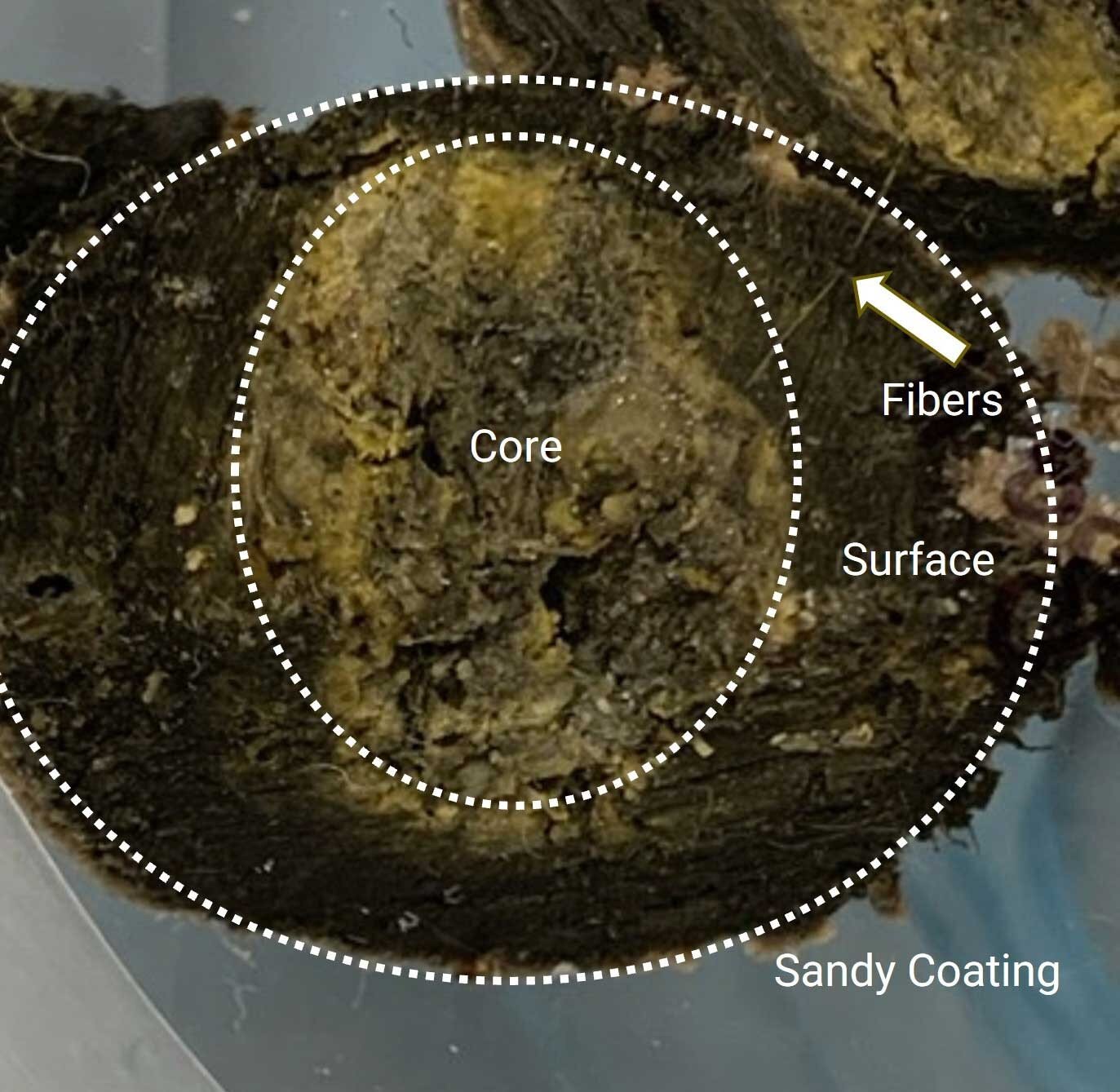

A multi-disciplinary team of scientists have made significant progress in understanding the origins of the mysterious black balls washing ashore on Sydney beaches.
A few weeks ago, thousands of sticky, round blobs washed up on shore after lifeguards first spotted them at Coogee beach, which left scientists with a series of questions about the origin and formation of the debris.
UNSW Science—partnering with UNSW’s Mark Wainwright Analytical Center (MWAC), DCCEEW Environmental Forensics, the NSW Environment Protection Authority (EPA), and Randwick Council—have run a series of analytical tests, to try and unravel this unusual marine mystery.
“At UNSW Science, we have been investigating the balls that appeared on Coogee Beach,” said Associate Professor Jon Beves, from the School of Chemistry, who led the investigation. “Our analyses show that the material is not natural and cannot be attributed solely to an oil spill. It is most consistent with human generated waste.”
The investigation used a combination of standard and advanced chemical analytical techniques to reveal the composition and potential sources of the material.
“We found the sticky spheres contained hundreds of different components, including molecules that derive from cooking oil and soap scum, PFAS chemicals, steroidal compounds, antihypertensive medications, pesticides, and veterinary drugs,” says Prof. Beves.
A combination of carbon
The first step was identifying the carbon composition of the balls, which would give the team an initial idea of the makeup of the debris.
Radiocarbon dating of the samples indicated that the interior of the balls contained about 70% modern carbon and 30% fossil carbon, while the surface was made up of approximately 85% modern carbon and 15% fossil carbon. Modern carbon includes carbon derived from plants and animals, as opposed to fossil fuels.
“This combination suggests a mix of substances derived from both fossil fuels and plant or animal sources,” says Beves. “The higher concentration of modern carbon at the surface may result from the loss over time of components that evaporate more easily.”
Comprehensive chemical analysis
The joint efforts of the research teams revealed that the dark, sticky material was composed of a complex mixture of fats, oils, calcium and other metals, inconsistent with typical marine fuel or oil spills.
The team also used advanced analytical techniques to characterize the material.
Elemental analysis, X-ray fluorescence (XRF) and energy-dispersive X-ray spectroscopy (EDS) revealed significant levels of calcium and lower levels of other metals. “While we’re not yet certain about the exact form of calcium in the samples, their presence suggests they might be combining organic components to form stable, water insoluble, solid masses,” says Professor William Alexander Donald, an analytical chemist involved in the research.
Spectroscopy tests evaluated the absorption and emission of light to reveal atoms and molecules in a sample. A type of spectroscopy, known as Fourier Transform Infrared (FTIR) matched the functional groups in the black balls to those found in soap scum and cooking oil, reinforcing the presence of domestic waste materials.
This also matched the nuclear magnetic resonance (NMR) data of the organic-soluble portion of the balls, which was consistent with fatty acids and olefins found in cooking oils and soap.
Mass spectrometry findings
The team also used a range of mass spectrometry techniques to identify a wide range of chemical components.
The analyses revealed the presence of alkanes typical of diesel fuel, fatty acids and other compounds commonly found in used cooking oils and soap. Additionally, perfluoroalkyl substances (the forever chemicals known as PFAS), steroidal compounds, antihypertensive medications, pesticides, and veterinary drugs were detected, consistent with contamination from sewage and industrial runoff.
Markers of human fecal waste, such as epicoprostanol and recreational drug residues like THC (from marijuana) and methamphetamine, were also identified—consistent with contributions from domestic sources.
Fat, oil, and grease blobs
The presence of fats, oils, and high calcium levels in the black balls suggests they could potentially be related to fat, oil, and grease (FOG) blobs commonly formed in sewage systems.
Chemically, FOG blobs can form through supramolecular self-assembly, where fatty molecules cluster together through weak, non-covalent interactions.
Calcium and other metal elements are known to enhance this blobbing process by binding to fatty acids and forming aggregates that don’t dissolve in water (soap scum). These masses can become dense and stable, particularly when fats encounter cool water, leading to the creation of sticky blobs.
“The black balls found at Coogee Beach have high concentrations of fatty acids, glycerides and calcium, similar to FOG deposits.”
Implications and next steps
The exact origin of the washed up balls remains uncertain, but the results emphasize the need for continued monitoring and vigilance to identify similar incidents, especially at smaller scales where they may go unnoticed.
Prof. Donald reflected on the investigative process. “This was a significant analytical challenge, with highly complex mixtures containing hundreds to thousands of components. We had a lot of fun analyzing these mystery blobs, using deductive reasoning to trace the likely source to human waste,” he says.
“Carbon-14 dating suggested they weren’t purely from an oil spill, as the material was mostly modern carbon, loaded with fats, oils, and greasy molecules. Detecting markers of human fecal waste—like coprostanol—alongside recreational drugs like THC and industrial PFAS ‘forever chemicals’ pointed us to sewage and other sources of urban effluent as the most consistent origins.”
Sydney Water have reported that there are no known issues with Sydney Water plants, so the origin of the balls remains unsolved.
The team has also been alerted to unconfirmed reports of smaller, similar balls washing up over the past two years, and further investigations could reveal whether these have related compositions or not.
Provided by
University of New South Wales
Citation:
Mysterious Sydney beach blobs: Scientists uncover their complex composition (2024, November 6)
retrieved 6 November 2024
from https://phys.org/news/2024-11-mysterious-sydney-beach-blobs-scientists.html
This document is subject to copyright. Apart from any fair dealing for the purpose of private study or research, no
part may be reproduced without the written permission. The content is provided for information purposes only.